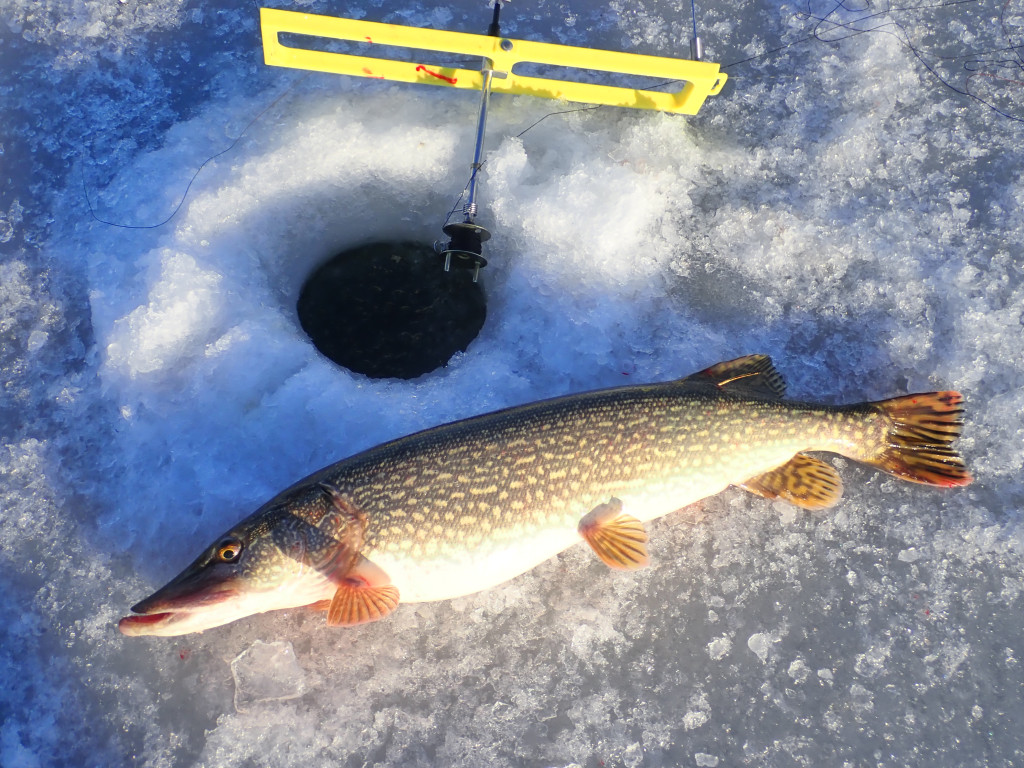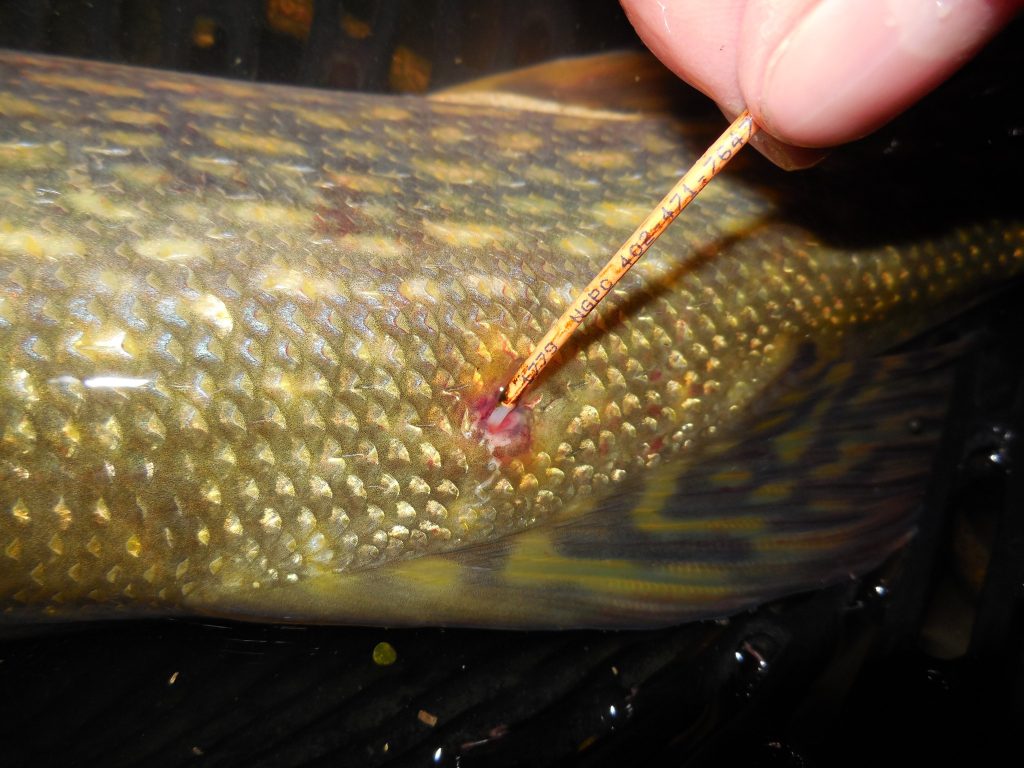
By Daryl Bauer
Have only fished the relatively new Flanagan Reservoir in NW Omaha a couple of times. Have caught a grand total of four northern pike there so far.
Two of them were tagged.
Previously mentioned some details about the first of those tagged pike. Let me return to that subject today, tell you about the other tagged Flanagan pike, and explain a little more about the fisheries work going on there.
Let me start all the way back with some biology about northern pike. I have said before, will again here. They are called “northern” for a reason. Northern pike are a cool-water fish. They have a circumpolar distribution around the globe. It is believed the southern extent of their native range was only as far south as northern Nebraska. Without a doubt, the farther south you go, even in Nebraska, the less desirable the pike habitat. We have documented summer die-offs of northern pike in some southern Nebraska waters simply because water temps. were too warm for them.
However, over the years when new reservoirs have been built, even in southeast Nebraska, those reservoirs were capable of supporting pike for some time. All waters age (eutrophication). Man-made reservoirs age relatively fast. As they age, habitat changes and so do fish communities in those waters. Yes, relatively new reservoirs might support healthy populations of northern pike. Unfortunately, that does not necessarily mean those reservoirs will always be pike fisheries. We have observed that exact progression on many Nebraska reservoirs as they age.
Currently, a couple of relatively new reservoirs in southeast Nebraska are offering pike fisheries, Wanahoo and Flanagan. With this opportunity, fisheries biologists from the Nebraska Game & Parks Commission have been tagging pike to track those populations and document their changes as those reservoirs age.
So far I have not been able to get out and assist with the pike-tagging at Flanagan. Have only participated on the angler end to this point.
I can tell you what the tags look like:

On Flanagan pike, those tags can be seen on the left side of the fish. Just under the dorsal fin. They can be easy to overlook. Yes, they are bright yellow tags, but they tend to accumulate algae and then are a lot less obvious.
That fish had tag #2567. She was tagged last spring and was 29 inches long at that time. I measured her at 32.5 inches.
You might remember how late winter hung on last winter (certainly not this winter, GRrrrrr). Pike spawn early, early spring, as soon as the ice is off. In fact with a late spring and late ice cover they will start spawning under the ice. We have fisheries personnel that collect pike eggs each spring to produce pike for stocking. Usually we do that work in western and northern Nebraska, but ice stayed in those parts way late last winter. As a result, we actually collected a few eggs from Flanagan northern pike last spring. Fish #2567 was a female from which some eggs were collected last year!
I can tell you that a total of 1,385 pike have been tagged in Flanagan so far. A tagging project can be used to estimate the actual numbers of fish in a population. The math involved at its foundation is a simple proportion. However, more advanced statistical models can account for mortality rates, tag losses, time, capture probabilities and a whole host of other variables. Simply put, those models are beyond my being able to explain them, but they can be used to produce more accurate estimates.
May not be able to explain all the calculations here. You would not want me to anyway, but I can tell you some of the bottom line numbers:
There are an estimated 719 northern pike in Flanagan. That works out to a little over 3 per acre.
Allow me to play some more with numbers:
Using some of the other data we have for Flanagan (2024 Omaha Area Fishing Forecast), that works out to 12 pounds, maybe a little more, of northern pike per acre in Flanagan. That number is what pointy-headed fisheries biologists would call a “standing crop” or “standing stock”. You can think of that as being representative of the carrying capacity of northern pike in Flanagan at this time. We have documented standing crops of pike nearly three times that great in Nebraska Sandhill lakes (which were some of the highest documented anywhere).
Anyway, northern pike are top-of-the-food-chain, apex predators. No waterbody can support as many pounds of predator fish as it can species lower on the food chain.
Said all of that to say this: Yes, there is a total catch & release regulation for all northern pike caught from Flanagan. If you look at those numbers you can see why. In a 225-acre reservoir located in the most-populated metro area of Nebraska, if ANY harvest of pike was allowed, it would not take long for them to be gone.
Also with a tagging project, we can estimate survival rates. Right now, the annual survival rate of Flanagan pike is about 80%.
We have stocked pike in Flanagan in 2018, ’19, and ’22. Pike stockings are planned for once every three years (’25 and ’28). Stocking more and more fish will NOT increase carrying capacity. There are only so many apex predators any waterbody can support. Eighty percent of them are surviving from year to year now, and growth rates are excellent.
As a relatively new reservoir, Flanagan likely is supporting about as many pike now as it ever will. It may expand a little more in this relatively new reservoir, we will see. But, it will not keep getting better and better for years and years.
Not to be “Daryl Downer”, but I am a fisheries biologist, and will tell you that over time, Flanagan probably will not have a pike fishery any better than it is currently. It may get a little better as fish have more time to reach maximum sizes. Likely, the Flanagan pike fishery will peak in the next few years.
Take advantage of it now! I plan to!
Put a leader on, handle ’em right, make it last as long as possible!
Thanks, Jake for sharing some data with me!
